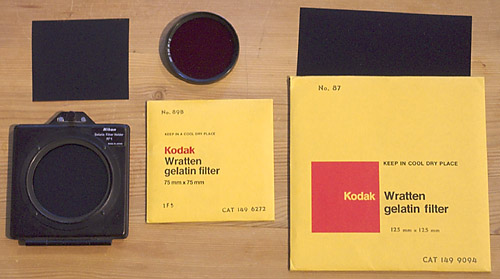| All You Ever Wanted to Know
About Digital UV and IR Photography, But Could Not Afford
to Ask |
|
 |
5.
Filters for IR
You cannot record infrared
images unless there are subjects which reflect at least some
infrared light, there are source(s) of IR light illuminating
these objects, and visible light is prevented from reaching the
CCD sensors. The last point, not entirely intuitive, results from
the fact that IR will record in CCD channels already sensitive to
visible rays. So, if visible light is allowed to reach the CCD,
it will literally wash out the IR image.
Because the filters are
opaque, you have to focus the lens before the filter is attached.
A hinged attachment that allows the filter to be swung out of the
way for focusing is highly practical.

|
| To capture
invisible IR rays onto your CCD, an opaque filter capable
of blocking visible light is needed. Not surprisingly,
such filters appear black to the naked eye. From left to right,
the filter types are as follows:
- The
'quick-and-dirty' IR solution: A cut piece of
non-exposed, but processed, E-6 film. It yields
quite convincingly IR images, albeit these come
out slightly on the soft side. I prefer using
120-format film because it is wider than 35 mm
material. Sheetfilm 4x5" is too thick unless
you love really soft images. A gelatin-filter
holder comes in handy for mounting the filter
onto the lens.
- Wratten
89B is a very dark black-red filter and probably
the one best suited to most digital cameras. It
produces a mild "IR look" and yet gives
useful speed response to the camera. An 89B can
be had mounted in glass (above) or as gelatine
sheets (below).
- Wratten
87 is a typical black IR filter which scarcely
lets any visible light through. Even the bright
sun disc will only show as a weak dullish red
glow. It is perfect for masking your flash so as
not to be seen when it fires, for IR candid
photography. It is readily available in gelatine
sheet form and can be had as resin or
glass-mounted filters as well.
While a 87 is the
filter to user for film-based IR, it often cuts
too much of the feeble IR sensitivity of today's
better dSLRs, in which the designers have done
their best to remove IR response. I have read
statements to the effect that the 87 filter is
optimal for the Nikon D100 camera, but haven't
tried to verify this myself. However, with D70,
the 87 works nicely.
Even denser filters, such as the Wratten 87C or
Hoya RM1000, are less suited for digital SLR
systems, because of the likely very low
sensitivity of the CCD sensor to longer IR
wavelengths. However, some DSLRs do take on even
these dense filters and I have obtained excellent
IR imagery with D2H and D70 using these filters.
Not surprisingly, the exposures do tend to get
long, so activating a noise-reduction feature is
paramount in this situation.
|
For a simulated "false-colour
IR" effect, you can shoot
through stacked polarizers. This technique, which may produce
quite pleasant images, is still poorly understood as to how the
colours arise. However, this shouldn't prevent anybody from
trying this approach.
If you want to go into filter
details, browsing the Kodak Filter Handbook may provide the
insight you need. Further pointers may be found at W.J. Markerink's website.
| All You Ever Wanted to
Know about Digital UV and IR Photography, But Could Not
Afford to Ask |
|